You might not be able to time the market, but you can certainly be strategic about how you manage your portfolio.
But being strategic takes more than following a "gut feeling." You need research and expertise to back up your decision-making.
That's especially true in today's market since we are getting such conflicting signals.
Volatility spiked to a seven-year high in December, just as the stock market closed out one of its worst years since this bull market started in 2009, with the Dow tumbling 7%.
Now, the Dow is up nearly 5% since the start of the year while the VIX is retreating below 20.
The market's whipsawing has investors uncertain about where it's heading next.
Don't Miss Out: The Treasury is sitting on an $11.1 billion cash pile, and a loophole entitles Americans to a sizable portion. Some are collecting $1,795, $3,000, or $5,000 every month thanks to this powerful investment...
With GDP growing more than 3% a quarter and unemployment near a 10-year low, we could certainly see another year of solid stock market growth. But this record-long bull market won't last forever, and plenty of threats are on the horizon. Between the government shutdown, Brexit, the trade war with China, and the Fed hiking interest rates, it only takes one event to trigger another sell-off.
But we've found one contrarian indicator that can help us make sense of where the stock market will move next.
And spotting patterns like this is the first step to making money, no matter what the markets throw at you...
The Unemployment Rate Is about Much More Than Jobs
The December unemployment rate came in at 3.9%, just a tick about November's 3.7%, which marked the lowest unemployment rate since 1969.
While that might sound like outstanding news, it could spell trouble for the stock market.
You see, when the unemployment rate hits its lowest point, future stock returns actually decline. And it goes the other way too. When the unemployment rate peaks - like the 10% unemployment rate in October 2009 - future stock returns trend upward.
You can see that relationship right here...

This might seem counterintuitive - after all, low unemployment is a good thing. But it makes sense once you think about it.
The economy (and the stock market) moves cyclically. So when unemployment bottoms out at its lowest rate, which is great for the economy, it also means there's little room for growth left. When the unemployment rate peaks, a sign of distress, it means a period of growth is on its way.
Eventually, the unemployment rate will rise again, while stock returns will fall. Just look at the chart.
And with the unemployment rate coming off a record low 3.7% in November, we very well might be turning the corner toward a new bearish trend.
Now, we're not saying it's time to sell your stocks and run. It's just time to be strategic. Consider adding trailing stops to your current stock positions to minimize your losses during a sudden sell-off. You might also want to look at rock-solid companies that consistently reward shareholders with income instead of taking a speculative position on an unknown firm.
Best of all, it's time to dig into even more independent research.
[Critical] These 4 Companies Could Unleash Up to $12 Billion in New Wealth by Jan. 31
Within the next five weeks, we could see as many as 10 private cannabis companies go public.
According to our research, four of them could set new opening-day records.
In fact, each of these companies is capable of generating between $500 million and $3 billion for investors the day they go public.
That's a potential $12 billion in new wealth created before Jan. 31.
To find out all of the details on each of these four IPOs - and how you can get in on them - even if you've never invested a dollar in your life, simply click here.
Follow Money Morning on Facebook, Twitter, and LinkedIn.
[mmpazkzone name="end-story-hostage" network="9794" site="307044" id="138536" type="4"]


